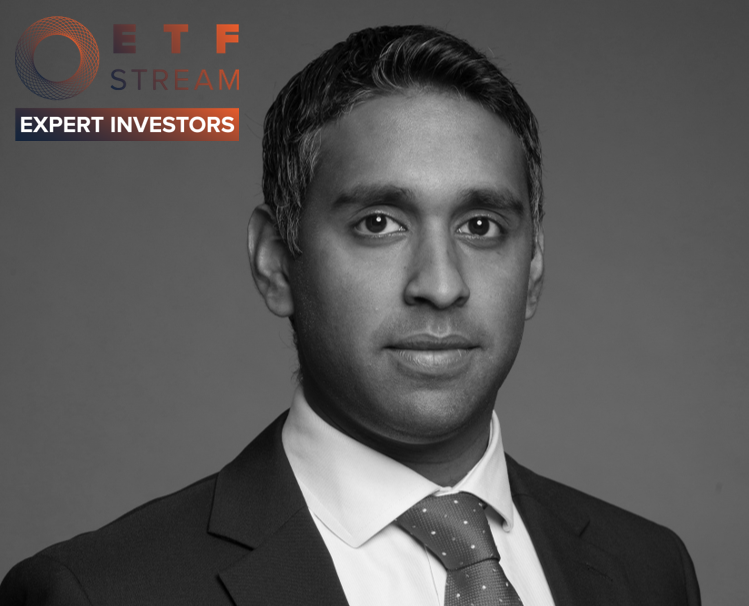brought to you by
ETF Stream
where on a fortnightly basis we interview the key individuals from across the fund selection and research space about the ETF ecosystem.
Fund selection plays a vital role in portfolio construction. Once the asset allocation decision has been made, these individuals need to decide how they want to be exposed, be it through a mutual fund, investment trust or ETF.
Over the years, ETFs have become an increasingly important part of any investor’s toolkit. This series will show how the key players across the fund selection space use ETFs in their portfolios while asking what more can be done by the ETF providers to help with the increasing adoption.
Next in the hot seat is Jordan Sriharan, head of managed portfolio and passive services at Canaccord Genuity Wealth Management (CGWM). Sriharan also sits on the portfolio construction and fixed income committees while specialising in managing investment portfolios for intermediaries, trusts, charities and pension funds. Prior to this, he managed corporate pension funds at Mercer between 2012 and 2013 having started his career at Fidelity Investments as a broker dealer.
How much of your portfolio is made-up of ETFs/index funds?
The MPS (managed portfolio service) is a mix of active and passive. The PPS (Passive Portfolio Service) is completely made up of ETFs, including equities, fixed income and alternatives.
It is difficult to replicate alternatives in a passive format, as they are built as actively managed investment approaches.
For example, the HFRX hedge fund index has been used as a benchmark in the past, but it has its inefficiencies. It is difficult to find passives in the alternatives space (one example is the GS absolute return tracker) and when you do, they tend to be quite expensive – almost as expensive as an active fund.
People think passives are an amorphous blob of beta, but there are limitations when investing exclusively in the passives space.
Yes, clients achieve cheap exposure to the market, but this can be considered ‘blind exposure’ if you do not fully research the ETFs you buy – passives should not be seen as a panacea, on their own.
When did you start investing in ETFs?
For the last seven or eight years. Passives – particularly equity markets – all have different biases. For example, in the UK, it is all about miners, materials, oil and gas and banks.
When the oil price tanked in 2015, lots of investors rotated out of active funds into passive funds because of the inherent sector bias in the FTSE 100 and did very well as they rebounded so quickly.
Seven or eight years ago, they started to become a really credible alternative to active managers who were charging large fees and underperforming.
Passives perform a different role in portfolios and as they have become larger, more established and more liquid, investors have become comfortable with them as a flexible investment vehicle.
Smaller pension funds will often invest just in passives – they are much more widely used in the pension industry than the wealth management industry and have been for a long time.
Which asset classes do you tend to invest in through ETFs?
With my ‘managed portfolio service’ hat on, we typically invest in developed market equities and government bonds using ETFs.
Which areas would you avoid?
Credit – both investment grade and high yield.
In the corporate bond space, the right active manager will buy companies that have robust cash flows, are highly profitable and have a low likelihood of defaulting.
Through an ETF, you own the whole asset class, so will have exposure to companies that do not fit that bill.
For better risk-adjusted returns, you are better off with an active manager who can weed out the high probability of default, CCC businesses. That is a better option than blanket buying the index.
What is your methodology for selecting ETFs?
The passive investment committee (PIC) undertakes research on passively replicated strategies and maintains an approved list.
Its primary role is to support the passive model portfolios, so that there are sufficient investment options to implement the investment views of the asset allocation committee.
The PIC aims to provide a comprehensive approved list of passively replicated funds which track their underlying index tightly, while in a structure that reduces non-market related risks.
We also select and monitor passively managed funds, including a due diligence process and monthly monitoring programs.
Do you have an ETF provider preference?
Broadly speaking, we do not have a preference for an ETF provider – we are conscious of ‘soft limits’ and putting all our eggs in one basket.
What ETF products would you like to see more of?
As mentioned, there is very little choice for ETFs in the alternatives space. More passive options for alternatives would be great.
Are there any areas ETF providers could improve?
My main point would be an improvement in the clarity and visibility of return profiles of ETFs against their active manager peer group.
To read the previous edition of Expert Investors with Lynn Hutchinson of Charles Stanley, click here.
Sign up to ETF Stream’s weekly email here



